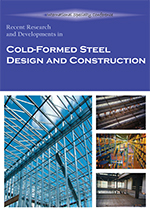Session Dates
24 Aug 2012 - 25 Aug 2012
Abstract
This paper summarizes results from an experimental program designed to evaluate the tension-compression cyclic axial response of cold-formed steel C-section structural framing members. A new cyclic loading protocol for cold formed steel members is presented that defines the target axial displacement based on elastic buckling parameters. The protocol is used to explore the cyclic response of members experiencing local buckling, distortional buckling, and global buckling deformation. In the experiments, post-bucking energy dissipation was observed along with tension stretching and softening. The quantity of dissipated energy per cycle increased as cross-section and global slenderness decreased. Specimens experiencing local and distortional buckling dissipated more energy per half-wavelength than those experiencing global buckling.
Department(s)
Civil, Architectural and Environmental Engineering
Research Center/Lab(s)
Wei-Wen Yu Center for Cold-Formed Steel Structures
Meeting Name
21st International Specialty Conference on Cold-Formed Steel Structures
Publisher
Missouri University of Science and Technology
Document Version
Final Version
Rights
© 2012 Missouri University of Science and Technology, All rights reserved.
Document Type
Article - Conference proceedings
File Type
text
Language
English
Recommended Citation
Padilla-Llano, D.; Moen, C. D.; Eatherton, M.; McAnallen, L.; and Bruce, T., "Compression-tension Hysteretic Response of Cold-formed Steel C-stection Framing Members" (2012). CCFSS Proceedings of International Specialty Conference on Cold-Formed Steel Structures (1971 - 2018). 5.
https://scholarsmine.mst.edu/isccss/21iccfss/21iccfss-session2/5
Compression-tension Hysteretic Response of Cold-formed Steel C-stection Framing Members
This paper summarizes results from an experimental program designed to evaluate the tension-compression cyclic axial response of cold-formed steel C-section structural framing members. A new cyclic loading protocol for cold formed steel members is presented that defines the target axial displacement based on elastic buckling parameters. The protocol is used to explore the cyclic response of members experiencing local buckling, distortional buckling, and global buckling deformation. In the experiments, post-bucking energy dissipation was observed along with tension stretching and softening. The quantity of dissipated energy per cycle increased as cross-section and global slenderness decreased. Specimens experiencing local and distortional buckling dissipated more energy per half-wavelength than those experiencing global buckling.



